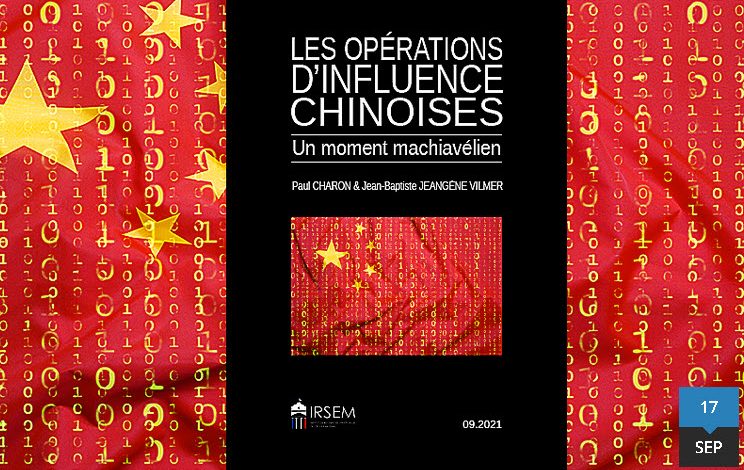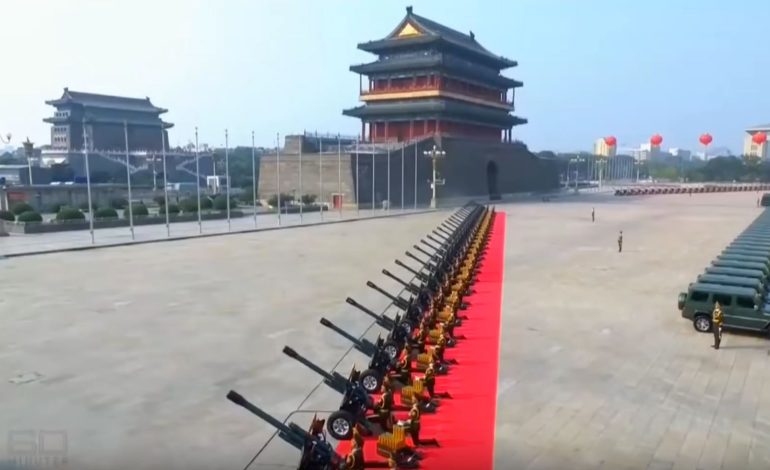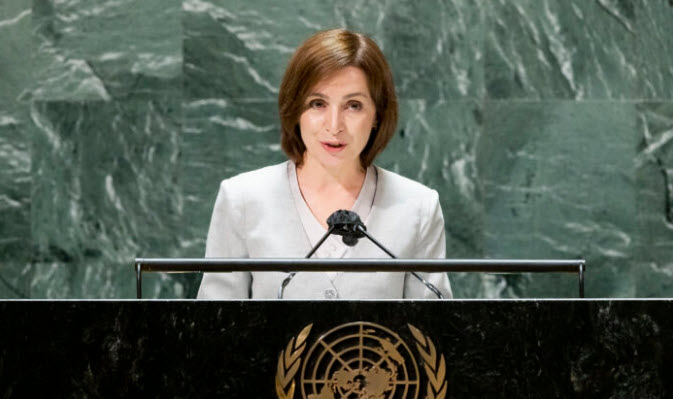
CHINESE INFLUENCE OPERATIONS: A MACHIAVELLIAN MOMENT
September 2021
By Paul CHARON & Jean-Baptiste JEANGÈNE VILMER
For a long time, it was said that China, unlike Russia, sought more to be loved than feared; that she wanted to seduce, to project a positive image of herself in the world, to arouse admiration. Beijing has not given up on seducing, its attractiveness and its ambition to shape international norms, and it remains essential for the Communist Party not to “lose face”. But, at the same time, Beijing is increasingly assuming to infiltrate and coerce: its influence operations have hardened considerably in recent years and its methods increasingly resemble those employed by Moscow. It is a “Machiavellian moment” in the sense that the Party-State now seems to believe that, as Machiavelli wrote in The Prince, “it is safer to be feared than to be loved.” This corresponds to a “Russianization” of Chinese influence operations.
This report focuses on this evolution, with the ambition to cover the entire spectrum of influence, from the most benign (public diplomacy) to the most malignant, that is to say interference (clandestine activities). To do this, it proceeds in four parts, successively presenting the main concepts; the actors implementing these operations, including Base 311 of the People’s Liberation Army; Beijing’s actions towards diasporas, the media, diplomacy, the economy, politics, education, think tanks and in terms of manipulation of information, among other levers; and finally some case studies (Taiwan, Singapore, Sweden, Canada, and the operations that targeted Hong Kong protesters in 2019 or sought to make believe the American origin of Covid-19 in 2020). The conclusion returns to this “Russianization”, which has three components: Beijing is inspired by Moscow in several registers, there are obviously differences between the two, and there is also a certain degree of cooperation. Finally, the report assesses the effectiveness of this new Chinese posture, which can boast of some tactical successes, but is a strategic failure.
1. Important concepts for understanding Chinese influence operations include those of the “United Front” – a CCP policy of eliminating its enemies internally and externally, controlling groups that can challenge its authority, building a coalition around the Party to serve its interests, and projecting its influence abroad – and the “Three Wars”, which represent the bulk of China’s “political war,” a form of non-kinetic conflict aimed at winning without fighting, shaping an environment favorable to China. Undertaken in time of war as in time of peace, it is composed of the war of public opinion, psychological warfare and the war of law (which is similar, without completely corresponding, to what is called in English the lawfare).
Another concept, of Soviet import, is also useful to describe the repertoire used by Beijing: that of “active measures”, including disinformation, counterfeiting, sabotage, discrediting operations, destabilization of foreign governments, provocations, false flag operations and manipulations intended to weaken social cohesion, the recruitment of “useful idiots” and the creation of façade structures (o ( front-end organizations).
2. The main actors implementing China’s influence operations are emanations of the Party, the State, the Army and enterprises. Within the Party,it is in particular the Propaganda Department, in charge of ideology, which controls the entire spectrum of the media and all the cultural production of the country; the United Front Work Department (DTFU), which has twelve offices, reflecting its main targets; the Department of International Liaison (DLI), which maintains relations with foreign political parties; the 610 Office, which has agents around the world acting outside of any legal framework to eradicate the Falun Gong movement; it is necessary to include in this group the Communist Youth League (LJC), at the same time a transmission belt to the youth, nursery for future Party cadres and a force that can be mobilized in case of need, even if it is not formally a Party structure but a mass organization.
Within the state, two structures in particular are involved in influence operations: the Ministry of State Security (MSE), which is the main civilian intelligence agency, and the TaiwanEse Affairs Office (BAT), which is in charge of propaganda to Taiwan.
Within the People’s Liberation Army (PLA),it is the Strategic Support Force (FSS), and in particular the Network Systems Department, which has the capabilities and missions in the information field. Specifically, the main actor identified in this area is Base 311, which has its headquarters in the city of Fuzhou, and is dedicated to the implementation of the “Three Wars” strategy. It also runs media companies that serve as civilian coverage and a fake hotel that is actually a training center.
Finally, both public and private companies play an important role in the collection of data on which the effectiveness of influence operations depends since it is necessary to know who to influence, when and how. In particular, infrastructure, including submarine vessels and cables, may be used for data collection; as well as new technologies, including digital platforms WeChat, Weibo and TikTok, companies like Beidou and Huawei, and databases offering insight into what researchers call China’s “techno-authoritarianism,” or “digital authoritarianism,” and which are being used to fuel and prepare for overseas influence operations. We should add the Joint Chiefs of Staff, which seems to have inherited the human intelligence missions of the former 2APL. However, due to a lack of sources, this report is not addressed.
3. The actions implemented by Beijing in its overseas influence operations fall under two main and non-exclusive objectives: on the one hand, to seduce and subjugate foreign audiences, by making a positive narrative of China, which is evidenced in particular by four narratives (the Chinese “model”, tradition, benevolence and power); on the other hand and above all, infiltrate and coerce. Infiltration aims to slowly penetrate opposing societies in order to hinder any attempt at action contrary to the interests of the Party. Coercion corresponds to the gradual expansion of “punitive” or “coercive” diplomacy to become a policy of systematic sanction against any state, organization, company or individual threatening the interests of the Party. Both usually go through a nebula of intermediaries. These practices apply in particular to the following categories:
– diasporas, with the dual objective of controlling them so that they do not pose a threat to power (Beijing is waging a transnational campaign of repression which, according to the NGO Freedom House, is “the most sophisticated, global and complete in the world”) and to mobilize them to serve its interests.
– the media, Beijing’s explicit goal being to establish “a new world media order”. To do this, the government has invested 1.3 billion euros per year since 2008 to better control its image in the world. China’s major media have a global presence, in multiple languages, on multiple continents, and on all social networks, including those blocked in China (Twitter, Facebook, YouTube, Instagram), and they invest a lot of money to artificially amplify their online audience. Beijing is also seeking to control Chinese-language media abroad, successfully since the CCP has a de facto quasi-monopoly situation, and the mainstream media. Finally, the Party-State is also interested in the control of the container, influencing every stage of the global information supply chain, with television, digital platforms and smartphones.
– diplomacy, and in particular two elements. On the one hand, influence on international organizations and norms: Beijing deploys not only conventional diplomatic efforts but also clandestine influence operations (economic and political pressure, co-optation, coercion and corruption) in order to strengthen its influence. On the other hand, the so-called “warrior wolf” diplomacy refers to the postures of the spokesman of the Ministry of Foreign Affairs and a dozen diplomats who show increasing aggressiveness. Attacks adopt classic but also relatively new forms, based in particular on the use of social networks and an uninhibited use of invective, admonition or even intimidation. Overall, this aggressive turn in Chinese diplomacy is counterproductive and has largely contributed to the brutal deterioration of China’s image in the world in recent years, but the evolution is undoubtedly sustainable because the objective of this strategy is less to win hearts and minds than to please Beijing.
– the economy, economic dependence on China being often the first lever used. Chinese economic coercion takes extremely varied forms: denial of access to the Chinese market, embargoes, trade sanctions, investment restrictions, quotas on Chinese tourism on which certain regions depend, popular boycott organizations. Beijing is increasingly making censorship a prerequisite for access to its market. And many companies end up bending under pressure.
– politics, with the aim of penetrating target societies in order to influence the mechanisms of public policy-making. Maintaining direct relations with influential political parties and personalities makes it possible to infiltrate target companies, gather official and unofficial support, and circumvent possible blockages within the government by playing on opposition or “retired” political figures. Beijing also practices election interference (in the last decade, China is said to have interfered in at least 10 elections in 7 countries).
– Education, first and foremost through universities, which are one of the main targets of the Party’s influence efforts. Its main levers are financial dependence, generating self-censorship in the institutions concerned; the surveillance and intimidation, on foreign campuses, of Chinese students, but also of teachers and administrators of the university, to change the content of courses, teaching materials or the programming of events; and shaping Chinese studies, inciting self-censorship and punishing critical scholars. The Party-State also uses universities to acquire knowledge and technology, through legal and undisguised means such as joint research programs, or illegal and covert means such as theft and espionage. In a context of civil-military merger, some joint programs or researchers accumulating positions at dozens of Western universities are unwittingly helping Beijing build weapons of mass destruction or develop surveillance technologies that will serve to oppress the Chinese population – several scandals broke out in 2020 and 2021.
Finally, there is another important player in Chinese influence in the field of education, which is also linked to universities: Confucius institutes and classes that are established all over the world and which, under the guise of teaching the Chinese language and culture, increase the dependence or even the subjection of certain institutions, infringe on academic freedom and could also occasionally be used for espionage.
– think tanks, the Chinese strategy in this field being dual, Beijing seeking to set up overseas branches of Chinese think tanks, and to exploit local relays that can themselves be think tanks, with three scenarios: punctual partners serving as a sounding board in local idea markets, allies of circumstance who work with the CCP on a regular basis and accomplices who share with it a a common vision of the world and whose interests are converging.
– culture, first through the production and export of cultural products, such as films and television series, music or books, which are powerful vectors of seduction. The influence is also exerted on foreign cultural productions, especially on cinema, with the example of Hollywood: in order not to upset Beijing and maintain their access to the gigantic Chinese market, many American film studios practice self-censorship, cutting, modifying scenes, even zeal, giving Chinese characters the “right” role. Denial of access to the Chinese market is a widespread practice for all artists critical of the Party-State. Through other types of pressure, Beijing also hopes to encourage artists to modify their works, or those who show them elsewhere in the world to stop doing so, or even to do the work of Chinese censors.
– manipulation of information, by creating false identities to spread Party propaganda in the media, by using fake social media accounts, trolls andastrosurfing (to simulate a spontaneous popular movement), using a large number of “internet commentators” (wrongly labeled “50 cent army”), paid to “guide” public opinion. Generally controlled by the PLA or the LJC, trolls defend, attack, maintain polemics, insult, harass. Another way to simulate authenticity is to have content published by third parties, for money (content farms, purchase of a one-time message, influence on an account, account or page, or recruitment of an “influencer”). Since 2019, Twitter, Facebook and YouTube no longer hesitate to identify coordinated campaigns as originating in China. Tens of thousands of fake accounts have been suspended, some “dormant” for a long time, others bought or stolen, amplifying Chinese propaganda and attacking the United States, in Chinese and English. Some accounts have AI-generated profile pictures – a practice now regularly seen in Chinese social media operations. An important aspect of these campaigns is that they do not just defend China: the promotion of the Chinese model requires the degradation of other models, especially that of liberal democracies, as Russian influence operations have been doing for years. The PLA is at the heart of these maneuvers: it uses social networks for” “open” influence, often for deterrence and psychological warfare, and clandestine and hostile operations against foreign targets.
– Other levers used by Beijing in its influence operations include citizen movements, in particular independence (New Caledonia, Okinawa) and pacifist movements (No Cold War group), Chinese tourists, influencers, including Western Youtubers and foreign academics, but also hostages since Beijing practices “hostage diplomacy”.
4. Case studies take the form of concentric circles. Taiwan and Hong Kong are the first front of Beijing’s “political war”: they are outposts, training grounds, “R&D laboratories” of Chinese operations, which can then be refined and applied to other targets around the world – as Georgia and Ukraine may have been for Russian operations. The first step in expanding the circle of Chinese operations focused on Australia and New Zealand. The second stage focused on the rest of the world, in particular, but not only, Europe and North America. This part presents four situations: Taiwan, Singapore, Sweden, Canada – and two operations: the one that targeted Hong Kong protesters in 2019 and the one that sought to make believe the American origin of Covid-19 in 2020.
Finally, the conclusion returns to this “Machiavellian moment” in two stages. First, to confirm that this is indeed a “Russianization” of Chinese influence operations since about 2017: the parallel had already been made in 2018 at the time of the Taiwanese municipal elections, then in 2019 during the Hong Kong crisis, and it was in 2020, during the Covid-19 pandemic, that the whole world became aware of the problem. This Russianization has three components, which are developed: Beijing is inspired by Moscow in several registers (and Chinese military literature recognizes that, for the PLA, Russia is a model to be imitated in this matter); there are, of course, differences between the two; and there is also a certain degree of cooperation.
Second, the conclusion also seeks to assess the effectiveness of this new Chinese posture and concludes that, while it involves some tactical successes, it constitutes a strategic failure, with China being its best enemy in terms of influence. The brutal deterioration of Beijing’s image since the arrival of Xi Jinping, especially in recent years, poses a problem of unpopularity for China that is taking on such proportions that it could ultimately indirectly weaken the Party, including vis-à-vis its own population.


